It’s 100% natural
Baking soda isn’t toxic to humans or the environment, and it’s packaged in compostable cardboard instead of plastic.


Last Updated: July 20, 2021
Baking soda is one of the best-known and most versatile natural cleaners, but how do you actually clean with baking soda? Grove writer Kristen Bailey gets cleaning to see what the science is behind baking soda as a household cleaner.
Baking soda is a multipurpose powder used for baking, cleaning, pest control, internal ailments, external woes — and science fair volcanoes. This almighty alkali can take the place of — or add muscle to — a whole slew of common, everyday cleaning products.
Today I’m going to try cleaning all the things with baking soda. Well, five of the things.
Baking soda, or “sodium bicarbonate,” is a crystalline salt. When it breaks down in a solution like water or blood, it forms sodium and bicarbonate, making the solution highly alkaline. As you might remember from 5th grade science, alkaline neutralizes acid.
So when baking soda meets an acid inside a liquid — or it’s exposed to high heat — it’ll produce fizzy carbon dioxide bubbles that give doughs and batters an airy texture and dissolve dirt and stains around the house.
Baking soda is a great household cleaner for a variety of reasons.
Baking soda isn’t toxic to humans or the environment, and it’s packaged in compostable cardboard instead of plastic.
A 16-oz. box of baking soda is generally under a dollar. A 16-oz. commercial, all-purpose cleaner is around $3 for the cheap, extra-chemical stuff.
Baking soda doesn’t spew toxic fragrances into your air to mask unpleasant odors. Instead, it neutralizes odor molecules.
As you’re about to see, baking soda — along with a few of its BFFs — can clean just about anything you put in front of it.
Pretty much anything you can clean with a general-purpose commercial cleaner, you can clean with baking soda, except for things like:
It may scratch the following materials due to its abrasive nature.
If you’re in doubt, try it out — test your concoction on a small, inconspicuous spot to see what happens.
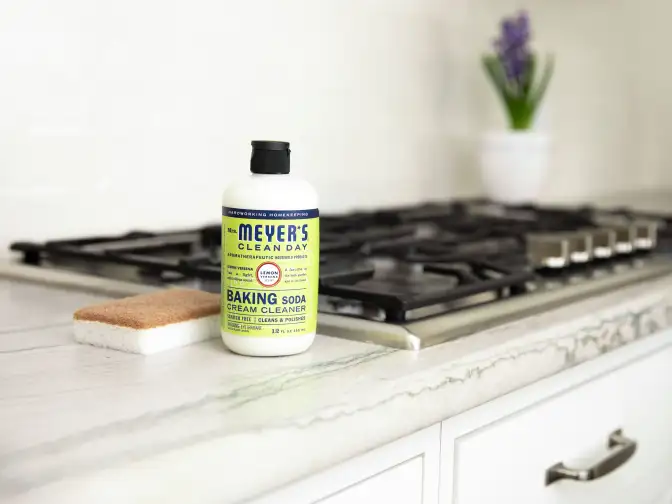
If you aren't into DIY but are intrigued by baking soda, try a natural cleaning product that uses baking soda as a main ingredient, like this Mrs. Meyer’s Cream Cleaner.
Plus, this Mrs. Meyer's Cream Cleaner channels scratch-free cleaning power of baking soda to help keep your pans, stainless steel, bathroom, kitchen, and other rooms their cleanest.

Wondering who Grove is, what types of products we offer, and how to get a free gift set when you sign up? Learn more about flexible monthly shipments, customizing your shipment, and joining millions of happy households — no monthly fees or commitments required.
For some jobs, you can apply baking soda right out of the box — sprinkle it on mattresses, carpets, upholstery, and other soft surfaces to absorb moisture, odors, and fresh stains.
You can also apply baking soda directly to these surfaces, and then use a spray bottle with a 1:1 vinegar and water solution to activate it.
In many instances, a paste works best. A paste adheres to vertical surfaces like walls, and as it dries, it absorbs stains. The thickness of the paste will depend on the type of job you’re doing.
This all-purpose paste is great for absorbing stains. Slather it on, let it dry, and then either scrub it loose with a dry brush and vacuum it up, or spray the dried paste with vinegar to activate the fizzy bubbles for another round of cleaning power. When that dries, scrub it loose, and vacuum it up.
Lots of baking soda cleaning recipes call for adding vinegar to baking soda to create a paste, and like we mentioned in the baking soda and water paste, it can activate a dried paste for a bit more cleaning. But, using vinegar and baking soda paste alone usually isn’t effective. Why?
Because when you initially mix them, you get those glorious scouring bubbles, but when the bubbly reaction is done — usually by the time you start to apply the paste — you’re left with mostly water and acetic acid, or sodium acetate.
Hydrogen peroxide has antifungal and bleaching properties. Add baking soda, and you’ve got a powerful solution for organic stains and rust.
Stir in a bloop of natural dish soap, and now you’ve got “oxygen bleach” — the water in the soap causes the paste to release an oxygen molecule that helps lift stains. Once the paste is dry, spritz on the 1:1 vinegar and water mixture, let it dry, scrub to loosen, then vacuum.
GROVE TIP
Lead Grove Guide Angela Bell says “Baking powder is a culinary cousin of baking soda — a mixture of sodium bicarbonate and cream of tartar.”
“Because it contains baking soda, it can step in for some cleaning uses but these two ingredients have a different chemical make-up and therefore, baking soda is going to work best around the house.”

I’ve had this cookie sheet for an eternity, and every now and then, I attack it with a steel wool soap pad (or a walnut scrubber alternative), but I’ve never gotten it very clean.
I’m interested to see if letting hydrogen peroxide-soaked baking soda sit on the pan overnight will make it easy to scrape off the baked-on, burnt-on grease and gunk in the a.m.

Here’s what the baking sheet looked like after I spent 10 arduous minutes scrubbing the bottom half of it with soap pads.

After that, I sprinkled the other half liberally with baking soda, spritzed it with hydrogen peroxide, and went to bed like it was Christmas eve.

Next morning, I rinsed the blue soap out of the soap pad and used it to scrub the top half of the pan for 10 minutes.

I sprayed the dried paste with more hydrogen peroxide to make it scrubbable, and it turned into the exact consistency of homemade shaving cream.
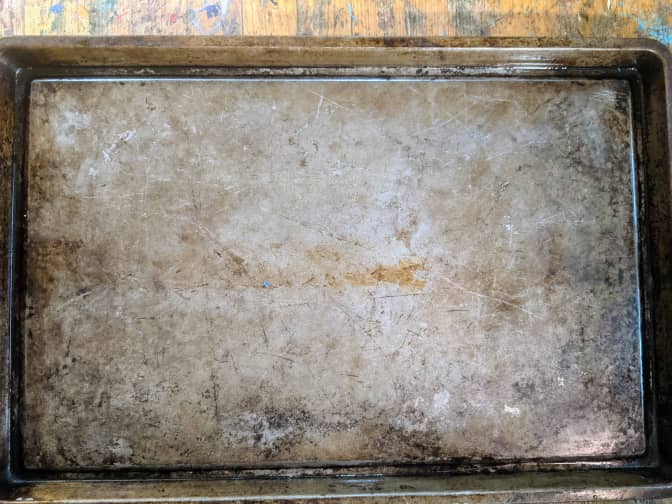
The baking soda and hydrogen peroxide paste did a pretty good job of it, considering. If I’d scrubbed it longer and with a more abrasive tool, I could’ve gotten it even cleaner.

We’ve lived in our house for 11 years, and I’ve never once scrubbed the grout on my hands and knees — and it shows! It has occurred to me that dark brown probably isn’t the actual color of the grout.
So, I was pretty excited to clean these 12 linear feet of grout with three different baking soda mixtures to see which works best.

Holy wow. Definitely not dark brown. So, which one worked best?
It’s kind of hard to tell — they all did a pretty good job of making me look like a slovenly housekeeper. But if I had to pick one, I’d pick #1, the baking soda + hydrogen peroxide + dish soap paste.
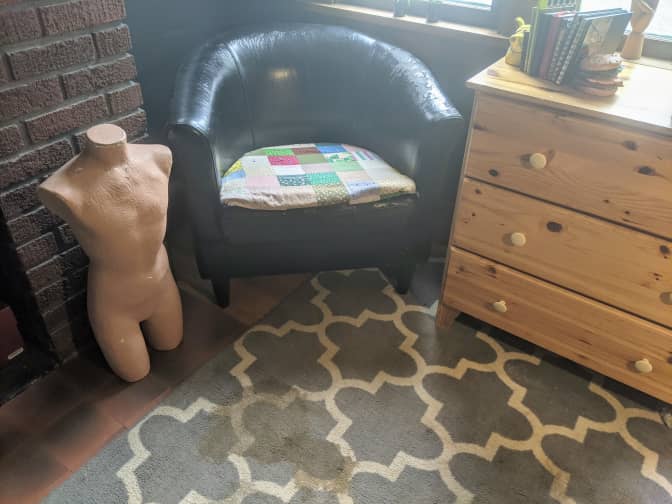
Early one morning last year, I was reading in my favorite chair in my office, my full coffee cup precariously balanced on the arm. The big dog was lying a couple feet away, and when his sudden, loud bark broke the deep, sleepy silence, I jumped out of my skin and sent my coffee flying.
I dabbed it up with a towel and scrubbed it with a commercial foam carpet cleaner. Looked great, for a while, but this is what it’s turned into — and it’s way worse than the original stain.
Let’s see what baking soda can do about this abomination.

I sprinkled a nice layer of baking soda on the stain and sprayed it liberally with a 2:1 vinegar:water solution until it started to bubble up.

I spent a few minutes in ASMR heaven watching that baby bubble, and then I walked away for 10 hours.

I came back later and used a scrub brush to loosen the dried baking soda. See how the baking soda paste absorbed the stain?
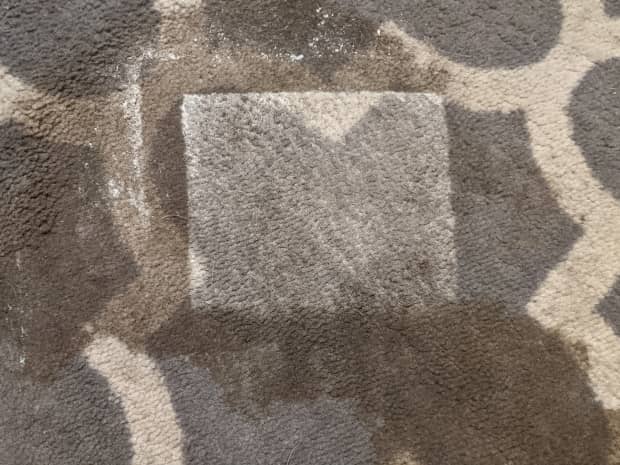
Vacuum up the now-dried, now-brown baking soda, and feast your eyes upon that stain-free carpet — that can’t be the real color of my carpet, can it?
I was pretty sure the baking soda or vinegar somehow lightened the carpet fibers. Could that be true?
Wow, that was a bad, nasty stain, and baking soda took care of it — a little too well. I’ll never use a commercial carpet cleaner again, and someday, maybe, I’ll finish the job with the baking soda — or pay my kid to do it.
GROVE TIPS
My hypothesis was that I had left the baking soda and vinegar on the carpet too long, and it bleached it. So I decided to experiment.
As it turns out, nothing bleached nothin’. My carpet really is just that dirty. I hope my mom doesn’t see this article.
Nope. If you rinse well after you vacuum up the baking soda, it should look great! But if it leaves behind residue, just wipe the carpet down with a damp microfiber cloth.
Most likely vinegar will not fade a carpet, but if your rug is made from natural fibers like wool or silk, test an inconspicuous spot. If it’s a very fine and valuable carpet, call in a reputable professional — don’t even mess with vinegar or baking soda.

Recently, someone decided to fill their motor scooter with oil — on the patio. According to the internet, it appears a baking soda and water paste is in the running with Dawn dish soap for the best ways to ditch the industrial degreasers and remove oil stains on concrete more naturally.

The contestants: Mrs. Meyer’s Dish Soap on the left, baking soda and water paste in the middle, and Dawn on the right.
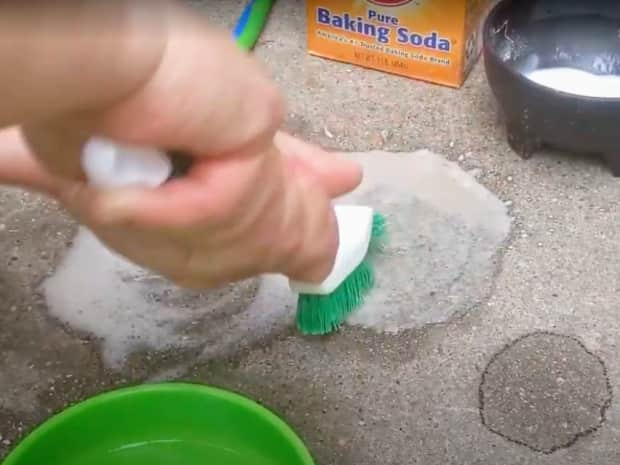
I vigorously scrubbed each circle for exactly one minute, thoroughly rinsing the brush between circles. Hosed it all away, and ...

Well, looky at that! Mrs. Meyers Natural Dish Soap beat grease-cutting king Dawn by the skin of its teeth — and both of them beat poor old baking soda.
Next time, I’ll try a baking soda and hydrogen peroxide paste with a couple of splots of Mrs. Meyer’s mixed in — and I’ll scrub for longer than a minute.
Baking soda is an alkali that interacts with acidic ingredients or stains — including coffee, condiments, and body fluids — to help remove them. In fact, sodium bicarbonate is added to many laundry detergents as a “builder” that softens the wash water, which improves the overall effectiveness of any detergent.
And that means you can use less detergent and save some dough.
It’s very doubtful, but if the baking soda isn’t thoroughly rinsed from your clothes, it may leave a white residue, which is easy to remove with a damp microfiber cloth.
Use your laundry detergent as you normally would, then add 1/2–1 cup of baking soda to the load.
For this test, I washed two equally sized small loads on a short cycle in cold water and tossed in the appropriate stain samples. I poured 1 tablespoon of natural laundry detergent in each load and a 1/2 cup of baking soda in the +BS load.
Here are the results:







I wasn’t expecting miracles, and miracles were not forthcoming. But if you look really closely, the baking soda grass looks slightly less bright than the non-baking soda grass, and the no-baking soda wine definitely still has a red tinge.
I did notice that the baking soda cloths felt softer than the no-baking soda cloths. Verdict? I’ll keep using it, since its effects can be cumulative. Why not?
There’s hardly a job baking soda can’t tackle. It’s the duct tape of naturally occurring salts. Here’s a brief sampling of what else you can do with baking soda.
Baking soda neutralizes stomach acid. When I was pregnant and suffering mightily from heartburn, a couple teaspoons of baking soda in six ounces of water was the only thing that did the trick.
Mix the baking soda with lemon juice for some extra vitamin C and some more neutralization.
Baking soda is mildly abrasive and breaks the bonds of molecules that stain your teeth — and it fights mouth bacteria with antimicrobial and antibacterial properties, keeping your teeth healthy and your breath fresh.
Lemon juice can also up the whitening power and give the treatment a better flavor.
Armpit sweat only smells once it’s broken down by bacteria into acidic waste products. Baking soda neutralizes the acidity to help reduce odors. Lots of deodorants contain baking soda, but in a pinch, you can just toss a handful of it at your armpits and call it good.
High-intensity exercise signals your muscles to produce lactic acid, which makes your muscles burn and lowers the pH of your cells, leading to muscle fatigue. Baking soda’s high pH may delay fatigue so you can power through your workout longer.
The pain and itch of bug bites, bee stings, and sunburn find welcome relief with a baking soda bath or a paste made with water and baking soda and applied to the skin. You can also add cornstarch or oatmeal to the recipe for more soothing relief.
Baking soda interacts with acidic odor particles and neutralizes them, which is why people stick an open box of baking soda in the back of the fridge.
You can also pour some into the bottom of your trash can, or make baking soda pouches to deodorize your shoes or car. Musty smell? Throw some baking soda at it.
Step away from the Roundup! To create a hostile environment for weeds in the cracks of your sidewalk or driveway without contributing to catastrophic environmental damage, sprinkle abundant baking soda over the intruders. But keep it out of your flower beds and veggie garden.
God forbid you’ve got roaches, but if you do, mix up a toxic little cocktail of baking soda and sugar, and put it in a jar lid for them to feast upon. It’ll cause their internal organs to explode, eek.
A 2017 study found that immersing apples for 15 minutes in a solution of one teaspoon of baking powder to two cups of water removes all traces of pesticides from the surface of the peel. That’s because sodium bicarbonate quickly breaks down the pesticides and makes them easy to rinse away.
To clear mild clogs, pour about a half-cup of baking soda down the drain and chase that with a cup of vinegar. Let it work for a half hour, then pour boiling water down the drain.
If that doesn’t work, read up on some more ways to make stronger drain cleaners here.

Conventional deodorant isn’t that great for your body or the planet, but is it true that switching to natural deodorant is a nightmare?

Vinegar is a great all-natural cleaner that’s been used in households for ages. But what really is vinegar and can it tackle nasty bacteria?

You're cleaning these nine things too often. We talked with Lead Grove Guide Angela Bell to get the facts and find out more about what we can stop cleaning!

How can you tell if you're using the right products to kill germs? Learn the difference between sanitizing and disinfecting from our team at Grove.